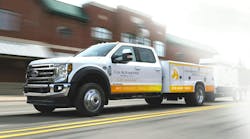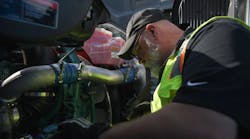Fleets today are faced with the challenge of figuring out what to do with all the data they collect. It’s certainly not the lack of data, but more so what to do with it.
Start the process by keeping it simple: look at the overall productivity picture of the shop.
A maintenance shop’s productivity is measured in hours worked. Is your shop making the most out of these hours? An evaluation of your current repair processes can help assess current performance to set a benchmark and can help improve shop efficiency.
The Truckload Carriers Association (TCA) recently held a forum to provide fleet maintenance personnel insight into best practices for maintenance workflow through a seminar titled Maintenance Workflow Best Practices, which is part of the TCA Profitability Program (TPP). TPP events are designed to provide best practices for fleets in any number of departments within the fleet operation, such as maintenance, safety, finance, and more.
TCA Managing Director Jack Porter led this particular program for attendees, sharing insights from his time as a consultant for both dealers and independent fleets.
He suggested a review of the current repair order process and a method for creating and monitoring consistent standard repairs.
Best practices for the repair order process
Productivity is measured by the number of hours paid, compared to the number of hours put into a job. To do this, compare shop hours versus repair order (RO) hours. Porter shared insights on how fleets can improve and optimize the RO order process in the shop.
Start at the front desk
The RO should be started on the system at the front desk, Porter says. He also stressed the importance of capturing a signature at the time the RO is created – either digitally or manually. If something happens to that truck and you don’t have a signature, you could face a lawsuit, Porter advises.
Use standard coding
The only way to review historical data and benchmark your operations is through standardization. Be sure that jobs are coded to standard repair times (SRTs) and with the vehicle maintenance recording standards (VMRS) established by the American Trucking Associations’ (ATA) Technology & Maintenance Council (TMC).
Nearly all attendees at the seminar recorded VMRS codes in some form, though it was up for debate how detailed each operation went. Recording only the three-digit code will provide a more high-level view. This represents the vehicle system. Many shops will record the six-digit code, which includes both the vehicle system and the component. The most detailed fleets record the full nine-digit code, which includes the vehicle system, component, and area of the component. It is important to note that you can always get less detailed, but if you’re not recording the data in the first place, you cannot get more granular.
Include PM details
When recording information on the RO, be sure to also include preventive maintenance (PM) inspection details. This process can be expedited with electronic recording systems, versus pen and paper. One reason is, job codes can also be pre-loaded with the parts necessary for that job depending on your maintenance software system.
Appoint a service coordinator
Another important aspect to consider is communication between the driver and the maintenance department, to gather additional information about the truck’s performance and potential issues. For consistency, have one point-person – such as a service coordinator – code every job.
Another suggestion that came from this discussion was issuing internal service bulletins on chronic repairs, especially when there are similar issues showing up in the same trucks. Alert your entire team about these issues, providing a workflow and parts necessary to fix the issue. This can also help your fleet watch for trends, and what parts are needed, helping to prepare for an influx of issues with similar truck models.
Figure out the top standard repairs
As it relates to standardization, consider building your standard repair times (SRTs) internally. Porter detailed that dealers often have a number of SRTs in place to quickly record the length of time a repair will take.
Creating SRTs benefit shops in two primary ways:
- SRTs give technicians an estimated amount of time for how long a job will take. Keep in mind, newer technicians will take longer. Seasoned technicians may be more efficient and take less time. Some shops also incentivize technicians for having a completed labor time under the SRTs they’ve completed.
- SRTs let operations know how long you’ll need that vehicle to be out of service to complete the work.
To establish a list of SRTs, start with the top jobs completed by your technicians on a regular basis. Porter suggested the top 30 repairs to start. You can create a baseline by asking technicians how long they believe it takes to complete certain jobs. Examples include the time it takes to complete PMs, wheel seal installs, brake jobs, etc.
Expanding on the SRTs, consider building out a standardized repair that not only includes the estimated time it should take a technician to complete the service, but also a parts list for that repair. This can help the technician no longer search for each part and plan ahead before getting into the service.
Communication and transparency with technicians are important. Be sure to get their feedback to ensure the SRTs make sense. If you change the SRTs, be sure to communicate changes with the technicians.
With any change, always consider employee buy-in. Change must come from the top down in order for the implementation of new processes to be successful.
Does your shop track top standard repairs? What tips can you offer others when it comes to improving the RO process? I welcome your insights. Feel free to share your thoughts at [email protected].


